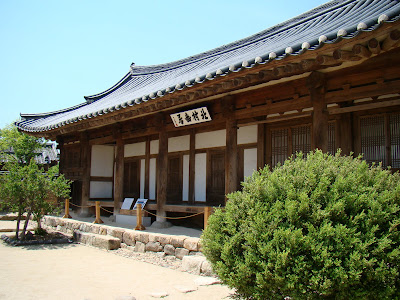The decendants of one family -- the Ryu's -- have lived in this village for over 600 years. Although they have added some modern updates -- electicity and plumbing, as well as automobiles and tractors -- the homes and other structures within the village are authentic. As we walked toward the village on a path through the surrounding wooded hills, I realized that we were about to enter the "Colonial Williamsburg" of Korea.
Just inside the primary entrance to the village, we came upon this example of a traditional home. This is actually just the front gate entrance to the family's compound. It consists of retored and updated structures owned by the CEO of a large Korean corporation. Our guide told that the reconstruction costs were in excess of $5 million US.
Here's Sandy and our guide, Young Ju, walking down a typical street in Hahoe.
Each of the established (wealthy) family homes is actually a compound of several buildings enclosed by a stone wall. Within the walls there will be a main dwelling for the women of the family, another dwelling for the men, dwelling for the servants usually built onto the interior side of the surrounding wall. Most of the family compounds will also have a Guest House like the one pictured above.
Within the walls of the next family compound, this calligrapher had set up a tent and would gladly write a word of phase of your choosing. I asked him to write the name that my department chair, Profressor Chi, had given me: 高 德
Situated at the very center of Hahoe Village is this 600-year old zelkova tree which the villagers call "Samsindang". The name means "shrine for three gods." According to traditional animistic beliefs, the tree is worshipped as a spirit. On the 15th of every January (by the lunar calendar), the villagers perform a ritual at the tree to pray for the peace of the village.
When I was walking back along one of the paths, this little sparrow caught my attention. It reminded me that no matter where you go in the world, you always find sparrows. And when I remember what Jesus taught. Not one sparrow falls to ground without the Father's knowledge. And as God cares for the sparrows, you can be assured He cares for you. You are worth more than many sparrows.
Yangjindang, one of the oldest houses in Hahoe Village, belongs to the head of the Ryu clan in the P'ungsan area. It is one of the Korean national treasures. Ryu, Seong-ryong (1542-1607), a famous court minister who helped protect Korea from the Japanese invasion of 1592, lived here.This is a picture of the interior of the large meeting room within Yangjindang. I made the grevious mistake, though, of stepping-up on the wooden deck structure that surrounds the outside of the building. The sign warning against stepping-up was written in Korean only. I should, however, have asked our guide before stepping-up and taking these pictures. My offense resulted in one of the other Korean visitors (who had observed my disrespectful conduct) giving me a sound chewing-out as I was later told by our guide.
Just a few kilometers down the Nakdong River is located Dosan Confucian Academy, one of the oldest in Korea. At the top of these stairs is the entry gate to the shrine within the academy's grounds that was built to house the memorial tablet of Yi Hwang (이황). Yi is one of Korea’s most celebrated philosophers.
At the end of this very full and inspiring day, our guide, Young Ju Choi, asked another visitor to snap this photo. We thoroughly enjoyed our visit to the "Williamsburg" of Korea.











No comments:
Post a Comment